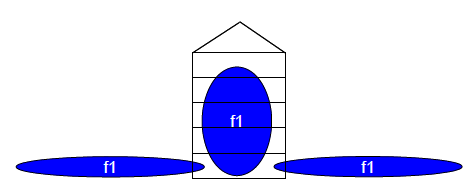1‐Macro sites
- Depending on the penetration of the macro sites indoor coverage can be achieved.- Bad coverage; especially for dense area.-
- Very hard to tune traffic to be dedicated for a certain indoor
2‐Micro sites
- Depending on the penetration of the micro sites indoor coverage can be achieved.
- Bad coverage; but better than macro sites
- Hard to tune traffic to be dedicated for a certain indoor
3‐Dedicated indoor solution (DAS)
Indoor planning process :
1-Demand
2-Capacity Dimensioning
3-Choice of antenna and RBS system
4-Antenna distribution
5-Freq plan
1‐Need for indoor sites (Demand)
1-Capacity :
-A certain potential building for traffic; can have a dedicated indoor
solution; though it might experience a good coverage level.
-The solution in addition to adding a new traffic (profit); provide a
relaxation in the capacity for the outdoor macro sites (capacity hot spots)
2-Coverage:
-For dense area; and due to building high density; indoor coverage may be lost though the site to site distance may reach; the only solution to provide an (every where coverage) is to dedicate an indoor solution.
- Needed for also complicated buildings (mega hotels; international air ports ….etc).
- Very critical for roaming excepted areas.
- The demand for indoors is increase as the power budget equation became more critical (higher technologies GPRS, EDGE …etc).
2-Quality:
- A dedicated solution for overcoming quality problem (Pilot pollution)
- Practically proven to add new traffic to the network.
Visit our Facebook Page
2‐Capacity Dimensioning :
Capacity figure per user is assumed for the indoor dimensioning
*High assumption for the in public building.
* Very high assumption for the in business building with lower GOS (0.5‐1%)
- Very High figures is assumed for the signalling dimensioning.
- Cell splitting for the high capacity building.
3‐Choice of antenna and RBS system
1‐Distrubted antenna
2‐Integrated antenna
One antenna is integrated in the Cab (special case of the disturbed antenna )
3‐Radiating cable (leaky feeder)
Special cable that act as a series of consecutive antennas.
More expensive; yet more flexible in design than normal antenna.
-Suitable for special pattern of coverage (tunnels; elevators….etc).
-Two types of losses associated with this type of feeders.
-Longitudinal loss (similar as normal feeder loss).
-Coupling loss (similar as normal antenna loss).
4‐Antenna distribution
Determine the design level of the signal strength
-Same as the coverage dimensioning of the macro sites.
-Practically depending on the level of the macro sites interference.
-Taking into consideration the expected data usage (C/I higher for a better through put).
- Practical values.
Visit our Facebook Page
Strategy for antenna distribution
1‐Few antennas with high power
2‐Many antennas with low power
- Better capacity situation.
-Obtain a uniform coverage pattern.
-Reduce interference to outdoor network.
Killer Mobile Effect
Strategy for connecting antennas for the RBS
1‐Passive system
-Using normal cables; splitters (equally losses disturbed) and tappers (un equally losses tappers)
-less expensive
‐ Adding big losses for the system (suitable for small and medium indoors)
2‐Active system
- Fiber Cables , repeater , or Eathernet Sysytem may be used.
-more expensive
‐ Adding low losses for the system (suitable for big and huge indoors)
3‐Hybrid solution where active & passive system may be used together
Use practical survey measurement to fine tune the antenna positioning
• Tools used
– Tems transmitter.
– Tems Receiver.
Visit our Facebook Page
Assumption may be verified to achieve the target signal strength (tappers instead of splitters….active distribution instead of passive….high output power RBS …etc).
3‐Antenna positioning guidelines
-Antennas to be placed in a zigzag manner for single cell indoors to achieve even coverage distribution
- Antennas to be placed over each other in multiple cells indoors to avoid
interference
More antennas needed in high floors to
overcome strong Macro interferes
-Avoid spill over with the outdoor macros
-No diversity in the uplink is needed.
5‐Freq plan
Using the first carrier (Macro Freq)
-Power dominance factor.
- Soft handover impact on Capacity Dimention.
-Spill over Calculations .
Using the Second Carrier
-Much Complex in parameter settings
-better quality and ECNO
-Further extensions in Macro layer should be taken into consideration



















